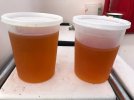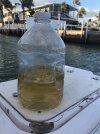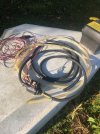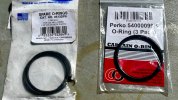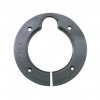How did you test for water in the fuel? How did you filter the tanks?
The most accurate way to check for water is to pull the sender and either hand pump out a sample or buy water detection paste that you apply to a thin stick and dunk in the tank.
In addition, if you drained a half gallon of water out of the separator, it would have had to be just about full of water. meaning there is a lot of water in your gas tank.
Just to clarify, I assume your water alarm is the sensor in the on the motor fuel filter. You didn't mention if you checked/drained any motor filters. You didn't specify your motor model. That might help
Engines are 2008 yamaha F250's with onboard filter with water float alarm. This has been an on-going issue and I thought I had finally discovered the problem - the round deck plates located directly over the sending units were bad and the sending unit wasn't tightened all the way down on the tank so water could leak thru the deck plate right onto the sending unit, and then into the tank from the poor seal.
After getting water in fuel alarm last season, I pulled the cock pit floor panel up and pulled out both the sending units (Aux and Main tank). I used a manual transfer pump from harbor freight to pump fuel from the bottom of each tank into a clear 5 gal water jug. I put a heavy brass fitting on the end of the pump hose so I could hear it hit the tank bottom and slide back to the very back corner of the tank. I had the boat tilted up really high so water would gather in the bottom back corner of tank where the pump hose would be sitting. I pumped into the clear jug until all the water was gone and I was only pumping clean fuel (you can see the water settle to the bottom in the clear jug). I did this for both tanks.
Once I was sure all the water was removed, I re-installed the sending units with some fuel resistant gasket maker sealant for good measure. I cranked the screws down as hard as I could. I coated the top of the tanks and even the sending units with a rubberized bedliner coating for belt and suspenders. I installed brand new OEM deck plates with water tight rated seals. Of course, I re-caulked the floor panel when re-installing.
It is next to impossible for any water to get on top of the tanks now and if it does there is a thick layer of waterproof coating to prevent it from going anywhere.
Before I stored the boat last season, I ran 50 miles with very frequent draining's of my water separators to ensure all the water was out of the fuel. I thought I had this problem licked once and for all.
However, this past weekend was my first time using the boat since then about 7 months ago. It took about 5 minutes of running before the water in fuel alarm sounded. I ran the boat, drained the separator, and repeated this. I pulled about 1/2 gal of water (again you can see it when it's in a clear jug).
So, somehow between last season and now, a lot more water got into my main tank. My Aux Tank thankfully was still clean fuel and I wasn't pulling any water from the separators when running on that tank.
The fuel vent is inside the fuel fill which is below the gas cap. The gas cap looks fine, has an O-ring. If you look at the gas cap it actually lips over the plastic nozzle receiver so it's not like rain or boat washing water can splash into it.
I'm just at a complete loss for how this much water can be getting into my fuel. The only thing I can think of is that last year when I had the water in the fuel I also had treated with a heavy dose of fuel stabilizer which I read essentially dissolves the water into the gas. I'm wondering if there was actually more water suspended in the fuel last season and over 7 months and temperature changes, phase separation occurred and the suspended water separated out and settled to to the bottom of the tanks.
Also, for whatever it's worth, the tank engineers were clever in making one of the pick-up tubes a lot lower than the other so it's only one engine water-separator that always picks up the water and not both.


